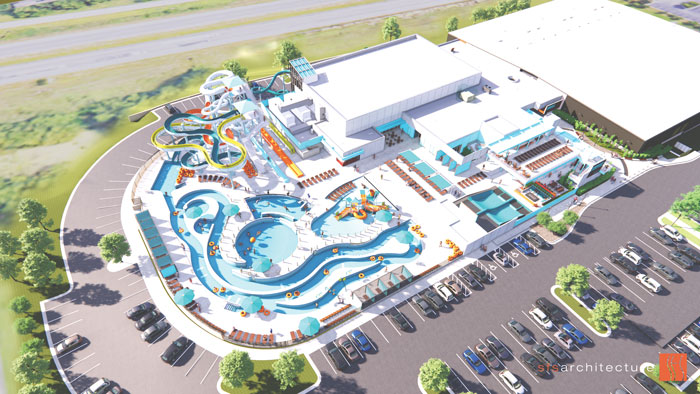As the traditional outdoor pools from the 1960s, ’70s and ’80s continue to reach the end of their lifespans, municipalities have been planning and executing what’s next for the community.
Aquatics upgrades target families locally and regionally, providing excitement, perceived return on taxes and economic growth through visits and recruitment of new residents. Towns across the country are turning small, feature-free and technologically outdated pools into waterpark-like facilities with fun attractions like slides and lazy rivers and separate pools for lessons and laps while pursuing and achieving financial goals, be it return on investment or increased membership and revenue.
If they’re not upgrading, they’re building new, like in Blue Springs, Mo., which will open a $40 million indoor/outdoor waterpark facility in May 2024. The city had previously had a 40-year-old outdoor pool that was designed for competition and lap swimming, was financially underperforming, and needed major repairs, according to Dennis Dovel, director of the town’s park and recreation department.
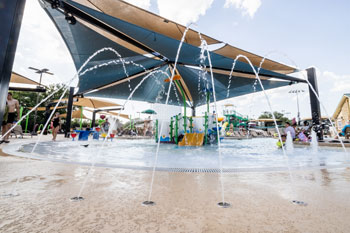
A feasibility study and the renewal of a park sales tax made the project a go. The facility will have approximately 60,000 square feet of outdoor aquatic space and 15,000 square feet of indoor pool space. Included in the outdoor section: a 590-foot lazy river with action channel and spray features, wave ball pool, social pool, zero depth entry pool with aquatic play structure, four waterslides including a stand-up slide, double surf simulator, concessions, observation deck with bar, rental cabanas and a sun shelf in the zero-depth entry pool for lounging.
The indoor area will feature a four-lane lap pool with a deep end and rock-climbing wall adjacent to the deep end, dive platforms, and an obstacle course system suspended above the entire pool. There will also be an indoor spray pad, warm water lifestyle pool with vortex, hydrotherapy, a teaching area, water exercise space and resistance walking river. The indoor pool will also boast a slide, whirlpool and sauna.
Dovel said community input was crucial to the project’s genesis. “Many communities around us had the more waterpark-setting features and our residents were communicating that is what they wanted,” he said. “You must listen to your residents to determine what they want and build a plan to meet those needs and give them a little more than what they expect. By listening and then exceeding the expectation, you build trust and desire to keep providing unique opportunities for the residents to utilize.”
Dovel said the town’s goals for the Blue Surf Bay project are to provide residents with a unique aquatic experience not found in similar nearby communities, to boost the department’s ability to positively affect the overall health of the community through fitness and wellness programs and services, and to recover 100% of the facility’s operational cost.
“Lastly, we hope to be an economic generator for the community by bringing in visitors and guests who then spend money in the community,” he said. “Our community has been saying it wanted a new aquatics center, but never thought it would be like this—this is beyond what it thought.
“We are not trying to be better than anyone, just trying to be the best we can be while serving our community. We have been focused on not settling for the same thing that others are doing or being trendy. Too many people settle for the ordinary. Try being extraordinary and see how the community responds.”
Not every community can afford such a facility, and fortunately there are plenty of lower-budget approaches. Upgrading a facility rather than building new is a good start to keep costs low, and adding features in phases helps as well.
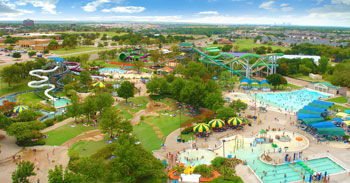
Jen Gerber, vice president of strategic partnerships and operations for aquatic design firm Water Technology Inc., cited the renovation of an old L-shaped pool in Grapevine, Texas. The original six-lane swimming pool no longer met the needs of the growing community, and rather than completely replace the pool, Grapevine decided to expand the pool footprint to include zero-depth entry with shaded interactive play area, an activity pool area with floatable play features, a water walk, a climbing wall and a slide tower.
The pool was also expanded to feature plenty of social space with more leisure water, underwater bench seating and a wet deck for lounge chairs.
“By expanding and upgrading existing facilities, municipalities can provide more opportunities for programs and revenue generation,” Gerber said. “In addition, it can improve outdated infrastructure, improve accessibility and enhance safety measures.”
Chris Smith, director of Grapevine Parks and Recreation, said that maximizing features and experience while mostly staying confined to existing space was the biggest challenge for Dove Waterpark. There was not a lot of space to use for expansion because the pool is boxed in by an existing sprayground, tennis courts, parking lot and open space for youth sport practices.
“Decisions and solutions were really a process of researching options, trends, local interest and various user needs—lessons, open swim, parties, toddlers, teens, events—and maximizing those opportunities in a cohesive design in a manner that was operationally feasible and sustainable,” said Smith.
“The changes and improvements made have resulted in a much better user experience, which has translated into the facility reaching capacity on many days and aquatic revenue being much higher.”
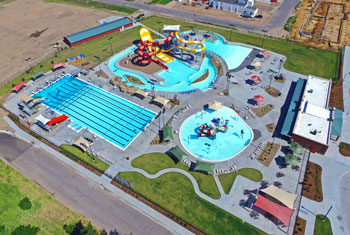
Smith said the project’s business plan called for 12,000 members; the member count is currently at 22,000 after eight years of operation.
“The goal for the remodel at Dove Waterpark was to take an old, worn-out body of water and transition it to an exciting, fun-filled waterpark for residents to enjoy,” Smith said. “We wanted to see attendance numbers increase as well as an increase in revenue to assist with the high level of costs associated with aquatic facilities.
“Results have been very positive, attendance numbers continue to stay very high, and revenue production from entrance fees, birthday party rentals and concessions continues to rise. Customer satisfaction and enjoyment is very evident.”
Smith has several bits of advice for anyone considering transforming a vanilla pool to an attractive and entertaining facility:
- Don’t try to tie an extended season sprayground into the same system. Grapevine had an existing sprayground that was tied into the same filtration, chemical and pump system, but operated separately. “Recommendations from our experience would be to keep both bodies of water completely separate so that an issue with one does not impact the other,” he said. “We would also recommend allowing both to operate within the confines of the waterpark and if desired have a method to allow the sprayground to operate into the off-season.”
- Make sure to separate your bodies of water to have maximum control, performance and customer satisfaction. Construction and equipment costs will be higher with the bodies of water being separate, but the separation will provide for much more flexibility, user satisfaction and lessened downtime, meaning if there is a fecal issue in one area, that area could be shut down and the remainder of the facility remain open.
- Whether considering new construction or renovation, it is very important to consider sight lines and view sheds so that you can get a grasp on the number of lifeguards you will need to properly and safely manage the facility. Amenities that prevent line of sight increase the number of guards and therefore increase the cost to run the facility. “Spend time working with the architect firm on ways to creatively design the facility to prevent any issues with views being blocked,” Smith said.
One of those design firm executives, Justin Caron, principal and CEO for Aquatic Design Group, said companies like his can help with much more than ensuring sightlines for lifeguards are maximized. Experienced consultants who have aided many different types of projects can also help with programming, community surveys and revenue generating ideas.
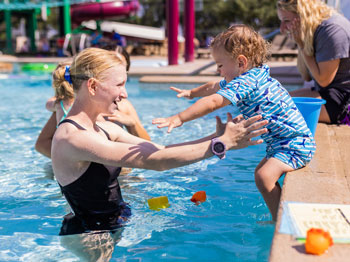
Caron said identifying the best ROI features is not easy because it will vary from facility to facility. “In some cases, simply adding Wi-Fi will bring more guests to your facility,” he said. “Others that are incredibly well-run with an underserved population won’t see a big impact as they’re already maxing out profitability. In general, adding an amenity that allows for additional charges will drive ROI more quickly than something that is just being added as part of the mix.
“Selling wristbands for $10 to use an inflatable or waterslide provides an easy-to-track metric. There may be additional revenue brought in that the ‘fun’ amenities don’t capture directly, but they certainly help. In general, a new addition that provides sustained interest and an experience that is lacking in your marketplace will have the best ROI.”
Gerber comes out strongly in support of her choice for best ROI addition. “Hands down the best opportunity for ROI in a municipal facility is rental space—specifically, shade and cabanas,” she said. “There are a variety of different shade solutions and rental space opportunities, ranging from a fully constructed pavilion to a simple canvas pop-up cabana or even shade sails. Large-scale waterparks often cite cabanas as their most successful ROI and that is absolutely the case in municipal environments as well.”
George Deines, studio director for aquatic design firm Counsilman-Hunsaker, said it’s imperative that operators understand that if they successfully attract the increased volume of users with the new builds or upgrades, they have to provide the amenities to accommodate the extra business. Along with concessions and larger changing areas and added social areas, safety and comfort are musts.
“Shade, shade and more shade!” said Deines. “Planning for shade and tables for 80% of your facility capacity is a goal that any aquatic facility should shoot for. At any given time, 50% of your guests are not in the water and need a place to cool off, eat a snack and socialize, and there’s no better place to do that than under a nice, shaded area.”
Deines said there are upgrades that should be in the plans of every municipality with a lower budget. His
choices not only appeal to families, one of them also can be used for multiple activities that draw different groups.
“Any features that drive family usage should be considered and well thought out,” he said. “The number one amenity I see requested is a zero-depth area where children can safely play within the supervision of their parents. The next two preferred amenities are waterslides and some type of moving water, like a lazy river, vortex or current channel.”
The latter can be used for fun and also for exercise and therapy, just as lap pools can be used for competitive swimming and instruction. Creativity is as important as smart design, budget limitations and understanding what the community wants and will want later, said Kyle McCawley, senior project manager for Water’s Edge Aquatic Design.
“It is beneficial for potential clients to have an idea of their goals and objectives for a project,” McCawley said. “For example, what does a successful outcome mean for them? Then, it is key to convey those goals to their design firm. This puts the project on the fast track to success.
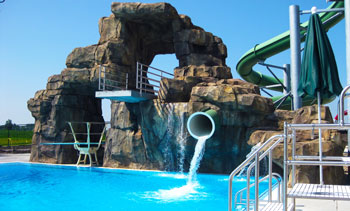
“The first exercise we guide our client through is to define the goal of the upgrade. Is the goal to increase attendance? Is it to increase cost recovery? Is it to fill a service gap? Once the goal has been defined, we explore a wide variety of upgrades that are designed to meet that objective.”
Frank Perez has been a part of the management of NRH2O Family Water Park in Richland Hills, Texas, since it opened in 1995. Considered to be among the country’s finest municipal waterparks, NRH2O has served nearly 6 million visitors and won 26 industry awards.
Perez said the facility planned to be able to pay for itself and to self-fund any upgrades and additions over the years, without tapping into tax dollars. One of the best ways to stay competitive is to constantly refresh, Perez said.
“In this way you can not only keep your facility successful, but also add valuable dollars into your community,” he said. “To do this, you need to look not only at what attractions or facilities you can add to achieve this goal, but also look at what kind of attractions will meet the needs of your populace. For example, you don’t want to put in the exact same slide that your neighboring city or waterpark has as you will not see a great return on your investment.
“One of the most important lessons is to always look at what the impact of a new attraction or facility will be. Will it bring in the attendance you are looking for? Will it fit your demographic? For example, if you only have families at your facility, you most likely want some type of family or group attraction and not a single-rider thrill ride. Also, find out and be knowledgeable about what your guests want you to add.”
Jennifer Kashner is an assistant recreation services manager for the city of Frisco, Texas, and has worked in aquatics for three municipalities in Texas that have upgraded their facilities or built new. She’s learned the importance of not only design but having people with an operational background do the designing. Issues like features that block the views of lifeguards or having separate pools run by separate systems so a problem in one doesn’t shut down everything are what operators who design keep in mind, she said.
“Having somebody on the team when you’re working with these municipalities, having that (operator) perspective, I think is important because you look at smaller towns, they don’t have an aquatics person, so they’re 100% relying on these designers to make sure that they have all the features, they meet code, but also that the companies are also giving them recommendations for staffing, where to put guards, what equipment is needed.
“You know, Oklahoma’s booming right now with towns building waterparks, and they’ve never had one before. So I think a lot of these towns rely on their expertise.”
When all is built or upgraded, those inexperienced towns will also need help learning how best to use the new features or facilities to best attract people beyond opening day. Caron said designers and consultants should be set up for this as well.
He said properly focused advertising can drive usage, and special events such as pumpkin plunges, pirate nights, summer luaus and dive-in movies can attract attention from people who may not normally visit.
“Hosting dry parties such as community meetings or banquets for non-aquatic sports can drive usage,” said Caron. “Wi-Fi, comfortable seating, welcoming spaces and places, and some light theming can all drive usage.
“Most important is people. Attract and retain fun, diligent, conscious staff who actually care. Your people will always be your most important asset and can either attract guests or repel them.” RM



